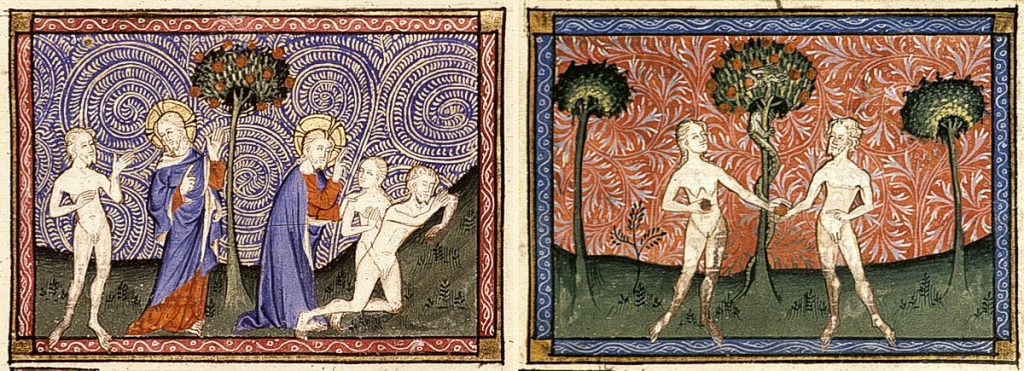Gender Roles & St. Paul
St. Paul is without doubt one of the most influential figures of the early Church. His letters constitute the bulk of the New Testament and shape our understanding of Christian anthropology. However, when reading Paul’s letters, one occasionally comes across passages that can — when taken out of context — make it seem like St. Paul is down on women. Given that Paul’s letters are scripture and therefore divinely inspired, are we to believe God wants women “kept in their place?”
A prime example is this passage from St. Paul’s first letter to Timothy.
It is my wish, then, that in every place men should pray, lifting up holy hands, without anger or argument. Similarly, women should adorn themselves with proper conduct, with modesty and self-control, not with braided hairstyles and gold ornaments, or pearls, or expensive clothes, but rather, as befits women who profess reverence for God, with good deeds. A woman must receive instruction silently and under complete control. I do not permit a woman to teach or to have authority over a man. She must be quiet. For Adam was formed first, then Eve. Further, Adam was not deceived, but the woman was deceived and transgressed. But she will be saved through motherhood, provided women persevere in faith and love and holiness, with self-control.
1 Tim 2:8-15
So what’s going on here? If we look at this one passage in isolation, it might seem like Paul is treating women as second class citizens of the Church. But the Catholic Church does not interpret any scripture passage in isolation.
How Are We To Interpret Scripture?
As Catholics, we believe that the scriptures are divinely inspired and are therefore true. St. Clement of Rome said that “nothing contrary to justice or truth has been written in them” (Letter to the Corinthians, 45). More recently, the Second Vatican Council has taught:
Since therefore all that the inspired authors or sacred writers affirm should be regarded as affirmed by the Holy Spirit, we must acknowledge that the books of Scripture firmly, faithfully, and without error teach that truth which God, for the sake of our salvation, wished to see confided to the Sacred Scriptures.
Dei Verbum, 11
Yet to claim that the scriptures are true by itself is insufficient. We must ask in what way they are true? Perhaps a better question would be what truth is God conveying in this text? As St. Hippolytus says, “Sacred Scripture is God’s gift to us and it should be understood in the way that He intends: we should not do violence to it by interpreting it according to our own preconceived ideas” (Against the Heresy of Noetus).
The Church teaches that the proper interpretation of scripture requires being attentive both to what the human authors wanted to affirm as well as what God wants to reveal to us by their words. We must ask how this passage fits not only with the context of the particular book in which it is found, but with the whole of Sacred Scripture and the lived tradition of the Church.
Immediate Context
To understand this passage from 1 Timothy, we first have to know the context in which St. Paul was writing. Who was he writing to and why? Timothy was one of the first bishops of the Church who had been given charge over the Church in Ephesus, in order to deal with certain problems that had arisen there. Ephesus was a Church in crisis. St. Paul mentions that he even had to excommunicate certain former leaders there (see 1 Tim 1:20). Timothy was meant to heal the wounds in the Church caused by this poor leadership.
Paul is writing to Timothy to offer instruction and encouragement in this important task. Some of the things Timothy is expected to do include teaching sound doctrine (1 Tim 4:6-7 and 6:20), appointing good pastors (3:1-13 and 5:22), overseeing prayer (2:1-8), supporting widows (5:3-16) and above all to keep himself free of sin (4:12, 5:22, and 6:11-14). And part of the erroneous teaching being circulated in Ephesus was the idea that marriage should be forbidden (4:3).
The passage we are looking at comes in the context of Paul’s instruction to Timothy on prayer. This is most likely in reference to liturgical prayer — the public worship of the Church which Timothy would oversee. Paul says that the men should pray “without anger or quarreling” and the women should pray “in silence” and without adorning themselves with flashy clothing.
Why does Paul single out these particular points for comment when addressing the conduct of men and women? It is not as if it is OK for women to pray in anger, or for men to dress immodestly. Paul is most likely addressing particular problems Timothy was facing. The men of Ephesus were involved in argument and dissension. The women were showing up dressed in flashy attire meant to draw attention to themselves. Paul admonishes both, telling the men that they should “lift up holy hands without anger” and the women that they should adorn themselves with “good deeds” instead of fancy clothing. If the men were dressing improperly and the women were quarreling, Paul would have no doubt advised Timothy accordingly.
Interpreting Paul with Paul
So what about women being submissive (1 Tim 2:11) and not being allowed to have authority over men (2:12)? Are we to read these statements as universally true? Not according to St. Paul.
The Church reads any particular passage of scripture in light of the whole. Here it is especially important to read this passage in light of other things St. Paul has written about women and men.
We know St. Paul’s instruction for women to be silent in church is not meant as an absolute prohibition because in 1 Cor 11:5 Paul speaks about women praying and prophesying in the assembly, which presumably involves speaking aloud.
Likewise we know St. Paul does not intend to forbid women from teaching, because in his letter to Titus (another early bishop), he says that it is good for older women to teach others in the faith (Tit 2:3-4).
The Church generally interprets this passage in 1 Timothy as an instruction that liturgical preaching is limited to those in ordained ministry, which is restricted to men. The Church certainly does not forbid women from teaching the faith. Most Catholics will have been taught during their lives at some point by nuns, religious women, and faithful lay women either in Catholic schools or parish religious education programs. And we cannot forget the great women saints whom the Church considers Doctors of the Church because of their contributions to theology, such as St. Theresa of Avila, St. Hildegard von Bingen, St. Catherine of Sienna, and St. Therese of Lisieux.
The same is true when it comes to women not having authority over men. We know St. Paul does not mean this as a universal truth because in his letter to the Ephesians he instructs husbands and wives to “be subordinate to one another” (Eph 5:21). Husbands are called to subject themselves to their wives and wives are called to subject themselves to their husbands. This mutual subjegation is the lens by which we are to read the rest of St. Paul’s instruction for married couples (Eph 5:22-33).
We must remember, too, that Our Lord himself submitted to the authority of his Blessed Mother, both as a child (see Lk 2:51) and as an adult (see the Wedding at Cana, Jn 2:1-11).

But what does Paul mean when he says Adam was made first and that it was Eve who was deceived (2:13)? Is he claiming women are lesser because Eve was made second? No.
According to Genesis 1:27, God created man and woman together, both in his image and likeness. According to Genesis 2:7, God man Adam first and Eve later (Gen 2:21-22). Why the discrepancy? The creation accounts in Genesis are not meant to give a chronological account of events. But both accounts convey the same truth in different ways. Man and woman are both made in God’s image and are of equal dignity. We are fundamentally the same. This is why in the second creation story, Adam cannot find companionship among any of the other creatures God has made. Only in Eve does he recognize one who is “bone of my bone and flesh of my flesh” (Gen 2:23).
Far from saying Eve is “less than” Adam because she was made second, Paul elsewhere expresses the fundamental equality in dignity between men and women. In his first letter to the Corinthians, Paul writes:
For man was not made from woman, but woman from man… Nevertheless, in the Lord woman is not independent of man nor man of woman; for as woman was made from man, so man is now born of woman. All things are from God.
1 Cor 11:8-12
While men and women are essentially the same and of equal dignity, we are also different from one another. This is not a flaw in our nature, but a design feature. In Genesis, it is written that “God created mankind in his image; in the image of God he created them; male and female he created them” (Gen 1:27). This means there is something in our maleness and femaleness that reflects the image of God, and if we ignore the difference between the sexes, the image of God becomes obscured.
Much of what we perceive as differences between the sexes is cultural. Cultural gender roles can be good or bad. As aspects of culture, they are subject to change. Pink is considered a girlish color today, but a hundred years ago it was considered a manly color. The scriptures don’t deal with this sort of cultural gender norm except superficially. By hearkening back to Genesis, Paul is directing us to think about the more fundamental differences between the sexes.
Paul writes, “Adam was not deceived, but the woman was deceived” (1 Tim 2:14). This is true. In Genesis 3:13, Eve says to God, “The snake tricked me!” But this does not make Adam blameless. If anything, it makes him more culpable because he ate the forbidden fruit with full knowledge. In both Romans 5:12-21 and in 1 Corinthians 15:22, St. Paul clearly states that sin and death entered the world through Adam. But Adam and Eve participated in the Fall differently and this is reflected in the different ways God deals with each of them.
To Eve God says, “I will intensify your toil in childbearing; in pain you shall bring forth children. Yet your urge shall be for your husband, and he shall rule over you” (Gen 3:16).
To Adam God says, “Because you listened to your wife and ate from the tree about which I commanded you, ‘You shall not eat from it,’ cursed is the ground because of you! In toil you shall eat its yield all the days of your life” (Gen 3:17).
The consequences of the fall are not merely punishment but penance. This means the consequence of sin will also be our means of salvation.
She will be saved through motherhood
This broader context helps us to understand what St. Paul says about the behavior of men and women in the liturgy.
“Men,” he says, “should pray, lifting holy hands” (1 Tim 2:8). Praying with hands raised is a traditional priestly gesture. The Jewish priesthood was masculine. This was one of the unique aspects of the Jewish religion. Most other ancient religions had both male priests and female priestesses. But that is not how God established the priesthood among his chosen people. In Exodus we read of how God selected Aaron and his sons to serve in the office of priest, which would be passed on from father to son with each new generation.
Clothe Aaron with the sacred vestments and anoint him, thus consecrating him as my priest. Bring forward his sons also, and clothe them with the tunics. As you have anointed their father, anoint them also as my priests. Thus, by being anointed, shall they receive a perpetual priesthood throughout all future generations.
Ex 40:13-15
In Jewish understanding, priestly work was essentially a fatherly task. They used the Greek word leitourgia to describe what priests did, which meant a “public work or service” (and where we get our word liturgy). It was considered as an aspect of Adam’s duty to labor in the world, not only by tilling the soil but by offering sacrifice and leading creation in praise of God.
This essentially masculine concept of priesthood continues in the Christian tradition, which is why we only ordain men and why we call priests “father.” By instructing the men to pray with holy hands raised, St. Paul is directing men to be good priests. We should not take this too literally. Not every man is called to the ministerial priesthood. Nor are women prohibited from participating in Christ’s universal priesthood as baptized members of his body. But being a priest is essentially a masculine vocation and every man is called to be “priestly” in his work and worship. Living their fatherly vocation is how men grow in holiness.
Regarding women, St. Paul says “she will be saved through motherhood.” What he is saying here is that women are saved through the one thing women can do that men cannot. This does not mean that all women must become wives and mothers any more than all men must become ordained priests. St. Paul elsewhere praises virgins and unmarried women (see 1 Cor 7:25-35). But whether married or celibate, all women are called to be spiritual mothers, just as all men are called to be spiritual fathers. Living our natural vocations as men and women, fathers and mothers, will lead to salvation “provided [we] persevere in faith, love and holiness, with self-control” (1 Tim 2:15).
In other words, regardless of our particular state in life as married or celibate, men and women will be saved as men and women by embracing the unique and complimentary way God calls each of us to participate in his fruitful and creative love through motherhood and fatherhood.
I’ll end by quoting another passage from St. Paul dealing with the sexes, this time from his letter to the Galatians.
There is neither Jew nor Greek, there is neither slave nor free person, there is not male and female; for you are all one in Christ Jesus.
Gal 3:28
Like any other scripture, we shouldn’t read this passage in isolation. St. Paul is not saying the differences between men and women don’t matter. He is expressing the important truth that the things that separate us in this world (including, since the Fall, our sexuality) do not separate us from Christ. It is only through Him, with Him, and in Him that men and women can be united as one.

